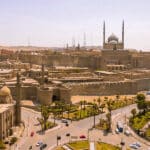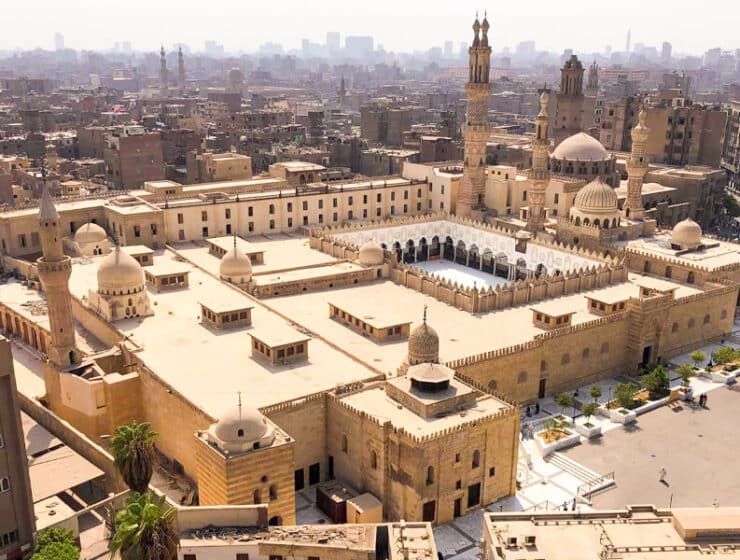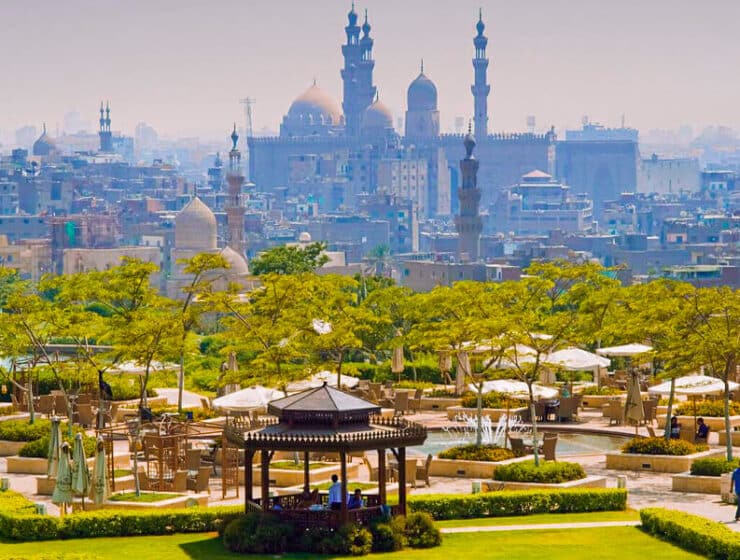The Qalawun Complex, a jewel of Islamic architecture, is a testament to the rich history of Cairo, Egypt. This magnificent complex is both a mausoleum and a religious institution, showcasing the Mamluk era’s architectural prowess and cultural significance. Built-in the 13th century by Sultan al-Mansur Qalawun, it has endured centuries of history, witnessing the rise and fall of empires yet preserving its timeless beauty. The Qalawun Complex offers a captivating blend of Islamic art and design, making it a must-visit for history enthusiasts and architecture lovers alike. This exploration will delve into this historical gem’s historical significance, architecture, and fascinating features, shedding light on the stories and legends that have become intertwined with its illustrious past.
Discover the charm of Islamic Cairo, a district steeped in history.
Historical significance of the Qalawun Complex
The historical significance of the Qalawun Complex is deeply rooted in its role as a symbol of Mamluk power and cultural heritage. Constructed during the Mamluk dynasty, this complex was more than just a remarkable architectural achievement; it was a testament to the sultans’ commitment to patronizing Islamic art, scholarship, and religious institutions. Beyond its stunning design, it was a hub for religious and scholarly activities, housing a madrasa (Islamic school) and a hospital. Furthermore, it is a reminder of the Mamluks’ contributions to Egypt’s history, including their efforts to repel the Mongol invasion. The Qalawun Complex remains a critical historical and cultural site in Cairo, drawing visitors and scholars from around the world who seek to understand and appreciate the legacy of the Mamluk era in Egypt.
Experience A Day in the Ancient City of Luxor.
Architecture and design of the Qalawun Complex

The architecture and design of the Qalawun Complex are a true testament to the ingenuity and craftsmanship of the Mamluk period. The complex exudes an aura of grandeur, characterized by intricate Islamic geometric patterns, towering minarets, and exquisite details. Its central feature is the mausoleum, an architectural marvel adorned with elegant Islamic calligraphy and ornate stonework. The layout of the complex, with its central courtyard and surrounding galleries, reflects the Mamluks’ dedication to creating harmonious spaces for worship, learning, and reflection. Notably, the mausoleum dome is a striking example of architectural innovation for its time. Overall, the Qalawun Complex is a masterpiece of Islamic architecture, offering a glimpse into the artistic and structural achievements of the Mamluk dynasty in the heart of Cairo.
Immerse yourself in the enchanting allure of Cairo by Night.
The main features of the Qalawun Complex
The Qalawun Complex boasts many distinctive features, making it a remarkable historical and architectural gem. At its heart lies the stunning mausoleum of Sultan al-Mansur Qalawun, with its intricate Islamic calligraphy, domed roof, and finely detailed stonework. Surrounding the mausoleum, a spacious courtyard invites contemplation with its serene fountains and lush greenery. The complex also includes a towering minaret, adding to its visual grandeur and serving as a prayer call for centuries. Inside, the ornate prayer hall showcases the Mamluk’s dedication to religious expression and artistic excellence. Beyond its religious functions, the complex houses a madrasa (Islamic school) and a hospital, reflecting the Mamluks’ commitment to education and healthcare. The Qalawun Complex, with its intricate blend of architecture, history, and cultural significance, is a testament to the enduring legacy of the Mamluk dynasty in Egypt.
Dive into Egypt’s cultural heritage at the Museum of Egyptian Civilization.
Historical events and anecdotes associated with the Qalawun Complex
The history of the Qalawun Complex is replete with fascinating events and anecdotes that highlight its enduring significance. One notable event is its construction by Sultan al-Mansur Qalawun in the 13th century, signifying the Mamluks’ dedication to architectural and cultural excellence. It also played a pivotal role during the Mongol invasion of Egypt, serving as a refuge and strategic stronghold during these tumultuous times. An intriguing anecdote is the restoration efforts led by the 19th-century ruler Muhammad Ali Pasha, who recognized the complex’s historical value and sought to preserve it for future generations. Additionally, tales of scholars and students who once studied in its madrasa or patients who sought care in its hospital add layers of human history to this architectural marvel. These historical events and anecdotes collectively weave a captivating narrative that underscores the enduring importance of the Qalawun Complex in Egypt’s history.
Make the most of your Cairo Layover Tours with our exclusive tours.
Restoration and preservation efforts of the Qalawun Complex

Over the years, the Qalawun Complex has benefited from several significant restoration and preservation efforts to safeguard its historical and architectural legacy. One noteworthy initiative took place during the 19th century under the rule of Muhammad Ali Pasha, who recognized the importance of preserving Egypt’s cultural heritage. His efforts included extensive restoration work on the complex, ensuring its structural integrity and intricate design were meticulously maintained. In recent times, the Egyptian government, alongside international organizations and experts in heritage conservation, has undertaken comprehensive restoration projects to combat the effects of time, pollution, and environmental factors. These efforts have involved cleaning, repairing damaged stonework, and implementing modern conservation techniques to protect this invaluable historical site. The ongoing dedication to preserving the Qalawun Complex underscores its significance as a living testament to Islamic art and architecture.
Visiting the Qalawun Complex: What to see and do
Visiting the Qalawun Complex is a captivating journey through history and artistry. Upon arrival, take a moment to marvel at the intricate details of the mausoleum’s facade, adorned with Islamic calligraphy and geometric patterns. As you step into the courtyard, you’ll find yourself in a tranquil oasis featuring lush gardens and fountains, perfect for peaceful contemplation. Take the chance to explore the interior of the complex, where you can admire the exquisite prayer hall, with its ornate decorations and architectural grandeur. While here, reflect on the historical events and significance associated with the complex. For history buffs, the madrasa and hospital areas offer a glimpse into the multifaceted functions of this remarkable site. To enhance your visit, consider hiring a local guide who can provide deeper insights into the complex’s rich history and architectural nuances. Whether you’re an architecture enthusiast, a history lover, or simply seeking a serene escape in the heart of Cairo, the Qalawun Complex offers a fulfilling experience.
Explore our Tours:
- 3 Day Tour To Cairo
- 3 Days Tour to Cairo and Bahariya Oasis
- 4 Days Bahariya Oasis from Cairo
- 4 Day Cairo Tour Package
- 5 Day Cairo Tour Package
- Day Tour To Egyptian Museum and Coptic and Islamic Cairo
- Islamic Cairo Tour To Famous Mosques in Cairo
- Day Tour To Coptic and Islamic Cairo
Interesting facts and trivia about the Qalawun Complex
The Qalawun Complex is a treasure trove of intriguing facts and trivia that add layers of fascination to this historical gem:
- Architectural Innovation: The complex is renowned for its innovative architectural features, including the pointed horseshoe arch, which became a distinctive element of Mamluk architecture.
- Burial Site: Apart from Sultan Qalawun himself, the complex houses the tombs of his sons and descendants, making it a significant family burial site.
- Sultan Qalawun’s Legacy: Sultan Qalawun was an accomplished ruler, poet, and arts patron. His contributions extended beyond architecture to his era’s cultural and intellectual life.
- Stunning Minaret: The complex’s towering minaret is an architectural marvel and a lighthouse for sailors navigating the Nile River.
- Historical Refuge: During the French occupation of Egypt in the late 18th century, the Qalawun Complex was extensively damaged as a makeshift barracks. This period marks a crucial chapter in its history.
- Influence on Later Architecture: The Qalawun Complex’s architectural style and design elements profoundly influenced subsequent Islamic architecture in Egypt and beyond.
- Modern Preservation: In recent years, the complex has undergone extensive restoration to ensure its longevity and preservation for future generations.
- Cultural Significance: It’s not just a historical monument; it’s also a vibrant cultural space, occasionally hosting exhibitions, cultural events, and religious ceremonies.
These captivating facts and trivia make visiting the Qalawun Complex an even more enriching experience, offering a deeper appreciation of its historical and cultural importance.
Similar historical complexes in the region

The Qalawun Complex is just one of many historical complexes in the region that showcase the rich heritage of Islamic architecture and culture. Some similar complexes worth exploring include:
- Sultan Hassan Mosque and Madrasa: Located in Cairo, this complex was constructed during the Mamluk era and is renowned for its grandeur and intricate design.
- Al-Azhar Mosque and University: Also in Cairo, Al-Azhar is one of the world’s oldest universities and a center of Islamic learning. The mosque’s architecture reflects centuries of history and scholarly tradition.
- Muhammad Ali Mosque: Dominating Cairo’s skyline, this Ottoman-style mosque within the Cairo Citadel offers stunning city views and is a testament to Egypt’s recent history.
- Ibn Tulun Mosque: Another architectural gem in Cairo, this mosque dates back to the 9th century and is known for its unique spiral minaret and well-preserved courtyard.
- Alhambra Palace: Located in Granada, Spain, the Alhambra is a masterpiece of Islamic architecture and art, featuring stunning palaces, courtyards, and gardens.
- Sheikh Zayed Grand Mosque: In Abu Dhabi, UAE, this modern marvel combines traditional Islamic design with contemporary elements, offering a breathtaking example of Islamic architecture.
- Topkapi Palace: Situated in Istanbul, Turkey, this palace served as the residence of Ottoman sultans for centuries and is renowned for its opulent architecture and historical significance.
- The Great Mosque of Cordoba: In Spain, this mosque-turned-cathedral symbolizes the blending Islamic and Christian cultures, boasting an iconic forest of columns and arches.
Experience life in ancient Egypt at the Pharaonic Village.
Conclusion: Appreciating the beauty and importance of the Qalawun Complex
In conclusion, the Qalawun Complex is an awe-inspiring testament to the magnificence of Islamic architecture and the enduring legacy of the Mamluk era in Egypt. This historical gem’s intricate design, architectural innovation, and rich cultural significance make it a must-visit destination for travelers, history enthusiasts, and fine art and culture admirers. From the intricate details of the mausoleum to the tranquil courtyard and the complex’s multifaceted history, the Qalawun Complex offers a profound appreciation for the artistic achievements and historical importance of its time.
Beyond its stunning architecture, the complex is a poignant reminder of Egypt’s resilience through centuries of change and upheaval. Its preservation and restoration efforts are a testament to the commitment to safeguarding our world’s cultural heritage. As visitors explore its hallowed halls and lush gardens, they become part of living history, connecting with the past and gaining a deeper understanding of the Islamic civilization’s rich contributions to art, culture, and scholarship.
In essence, appreciating the beauty and importance of the Qalawun Complex is not merely a journey through time but a profound experience that deepens our understanding of the interplay between history, art, and the enduring human spirit. It is a beacon of Egypt’s historical and cultural identity, inviting all who visit to be captivated by its timeless allure.





